Invitation to Explore Shapes Through Clay
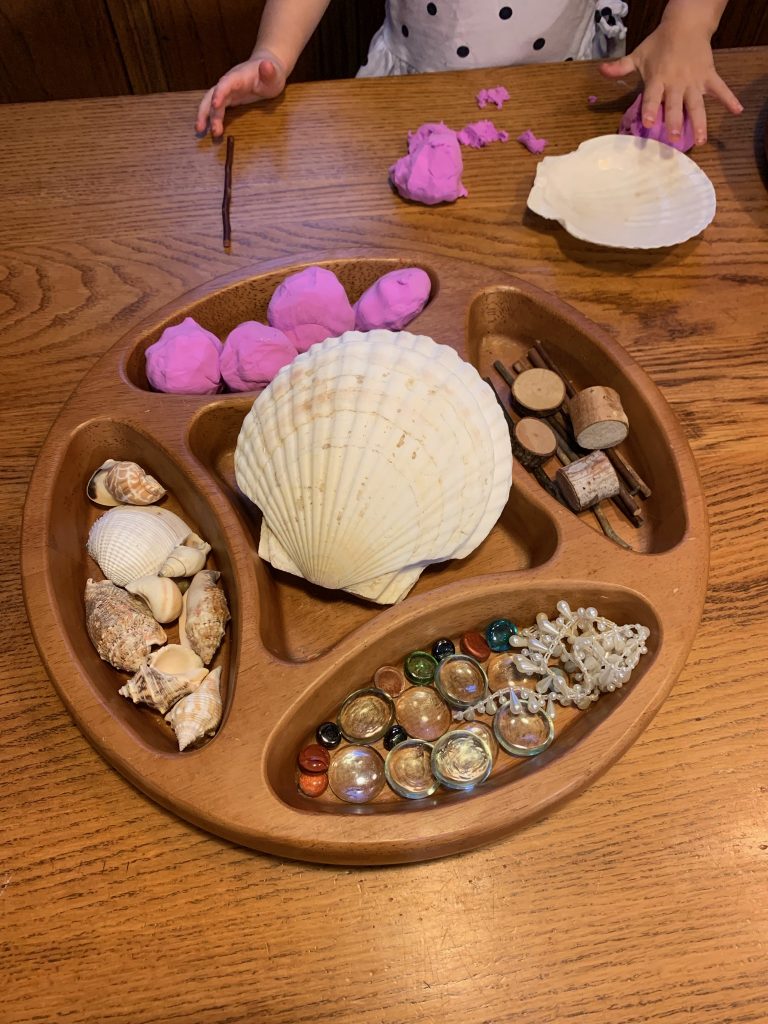
A parent recently asked me if we had been working on shapes because her two-year-old was quite knowledgeable about the topic. I just smiled, because we work on shapes all day long, starting with breakfast. Would you like circles (Cheerios), squares (Chex) or hexagons (Crispix)? Math is embedded in many of your daily activities as well. We just need to train our senses to find the math!
So, where is all the math in this clay area that we are creating?
When a new child joins our clay table, only to discover that there is no clay to be had, the children in our group know that they can each contribute a bit of their own clay to make a nice clay ball for their friend.
This is decomposition! The children have learned that a whole can be decomposed into parts.
This is problem-solving!
This is adding parts to make a whole ball of clay for their friend.
And you, my friend, aren’t even coming to my table because you are “allergic” to playdough and clay—the same way that I am “allergic” to glitter. Ha! Gotcha!
I promised you lots of tips to make this an easy and successful setup. I wouldn’t be writing a blog about clay if I weren’t passionate about it. Honestly, it’s THAT good! Come , let me share my clay with you.
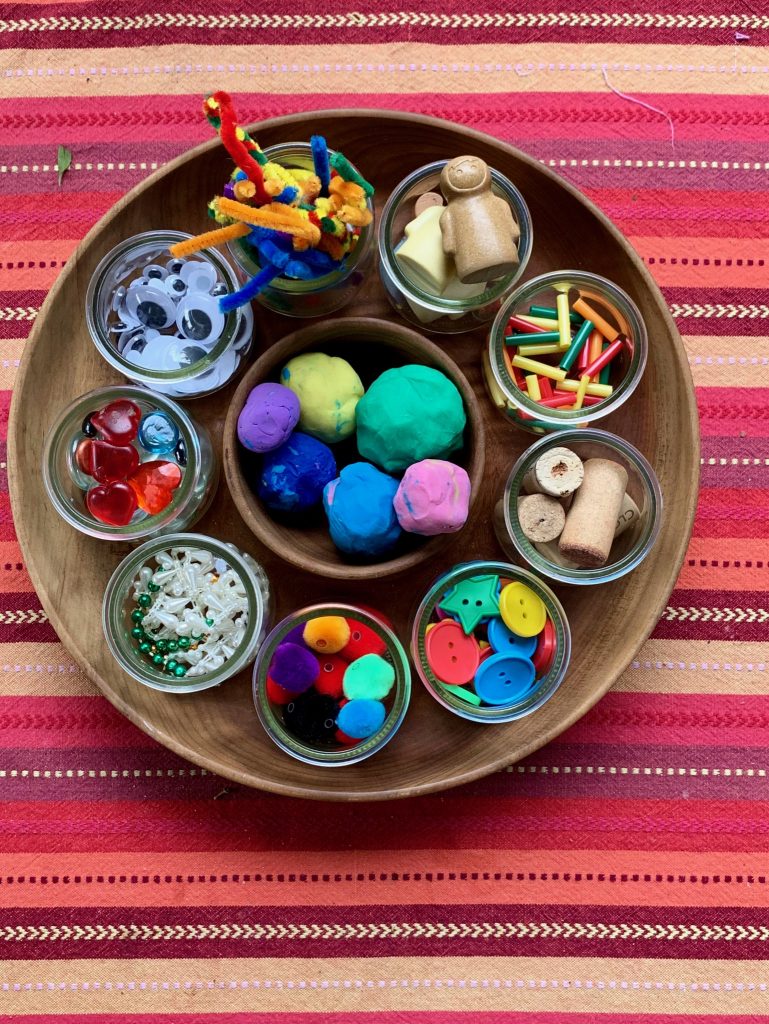
More about trays
We talked earlier in the month about trays. Adding a tray full of loose parts is as important to the play as the clay itself. Look for trays that are big enough to hold heavy clay and loose parts. I really like wooden trays with sections, but we use baskets filled with empty yogurt cups. We LOVE the new Oui yogurt glass containers! I love the transparency and beauty of these. You will not believe how strong these glass containers are. Ours have fallen onto our hardwood floors and outdoor deck without a chip or a nick. They just add to the sense of beauty with the wood that I think adds to the calmness of our clay.
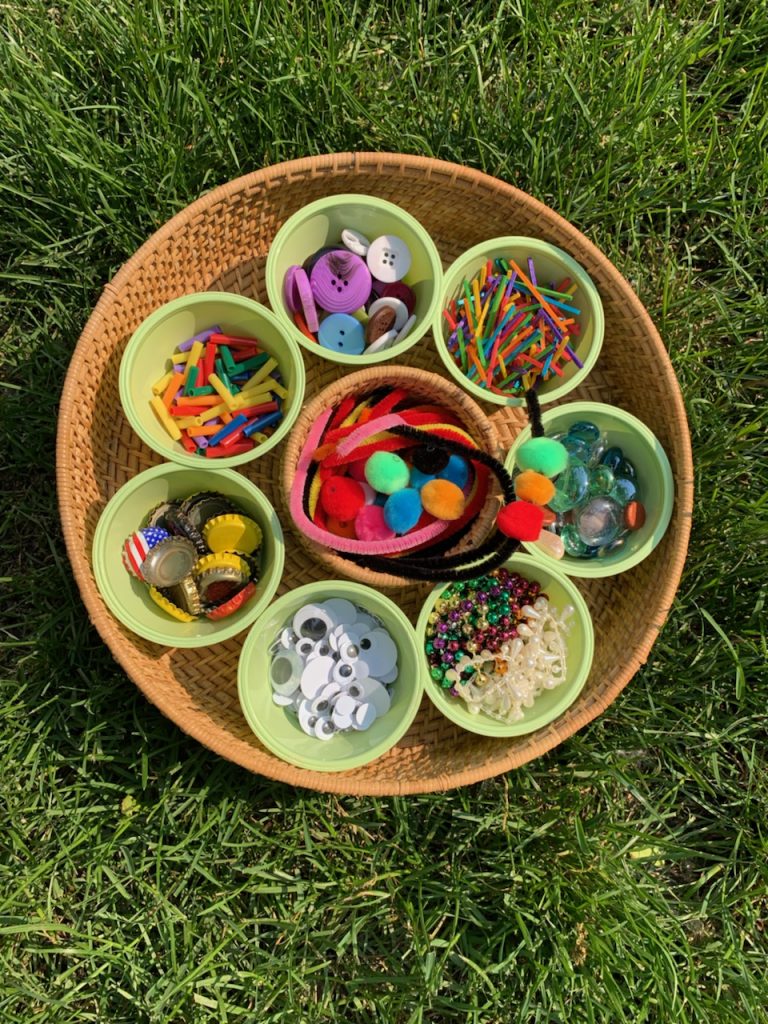



Loose parts
I dispensed with cookie cutters years ago because I believe that they restrict my students’ creativity. The use of open-ended loose parts and small objects triggers imaginative play and prompts children to investigate new ideas. The more time that children spend playing with clay and objects, the more confident they will become about their creations. The trays and shallow baskets that we use to organize our clay and loose parts also come in handy when it’s time to clean up. Trust me, it won’t look as beautiful as when you started, but everything can be put away quickly, which is priceless for every teacher I know! Designing, creating, building, arranging and restoring order will come naturally to children through their clay time. You will see patterns, symmetry and shapes explored. When we use trays with separate compartments, this helps foster the development of early math skills and encourages children to put loose parts back where they came from.


Clay for sensory kids
For children with sensory issues, we have used popsicle sticks, chopsticks, toy cars, toy dinosaurs and other materials to coax them into the clay zone.

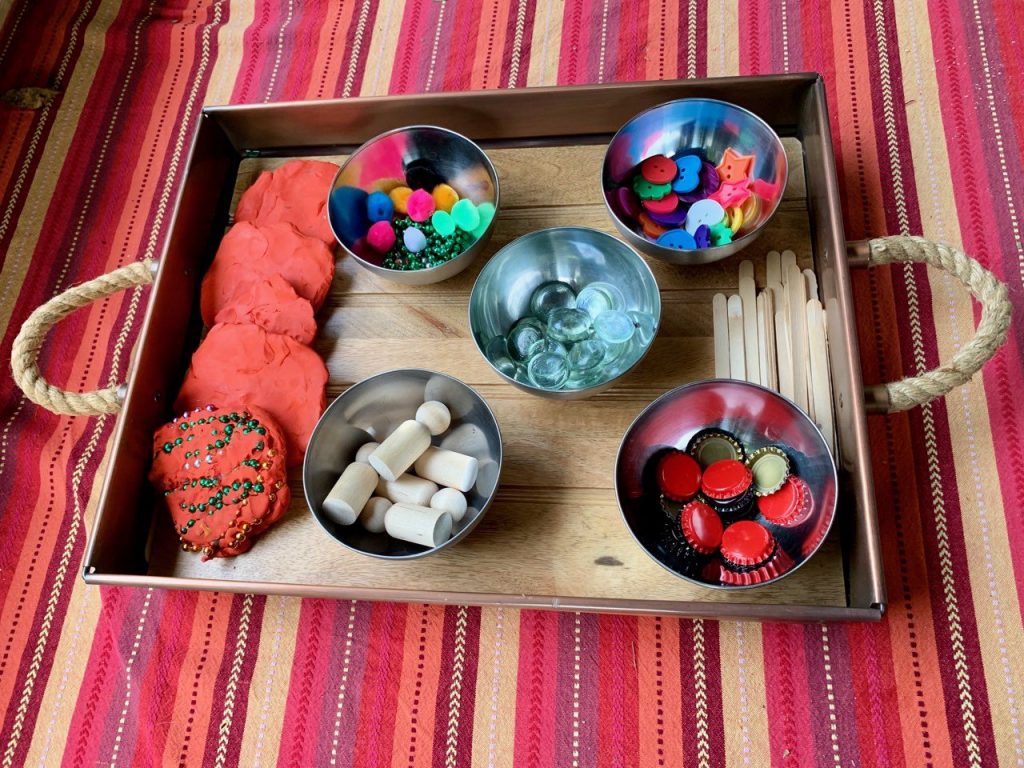
Hard clay
If the clay is too hard when you first bring it out, it’s likely cold. We warm it up by making snakes. We also stretch the clay and make it LONG and THIN instead of SHORT and THICK. By starting the younger students out with flattened clay (think of a pancake), you are saving yourself time. The older, stronger students can begin with a ball to really work those hand muscles, but save yourself some time and start flat with the little ones.
Outdoor clay
On a ninety-degree day, this clay will remind you of crayons that melt in the hot sunshine. We tried working with clay outside in the sun on a hot day and ended up with clay soup. I’m sure the clay is fine when it cools down, but mine and everything that was stuck to it went straight into the trash. We’ve played with pliable clay in the shade on very hot days, but take my advice when I tell you to avoid direct sunshine—or you will be writing to me in the comments section below!
If your winters are cold, this is a great time to keep your clay stored in flat pancakes, not balls. I try to keep the clay in a warm area such as the top cabinet above the stove. Avoid cold basements or porch areas—and please don’t try to warm it in the microwave. (Just trust me on that.)
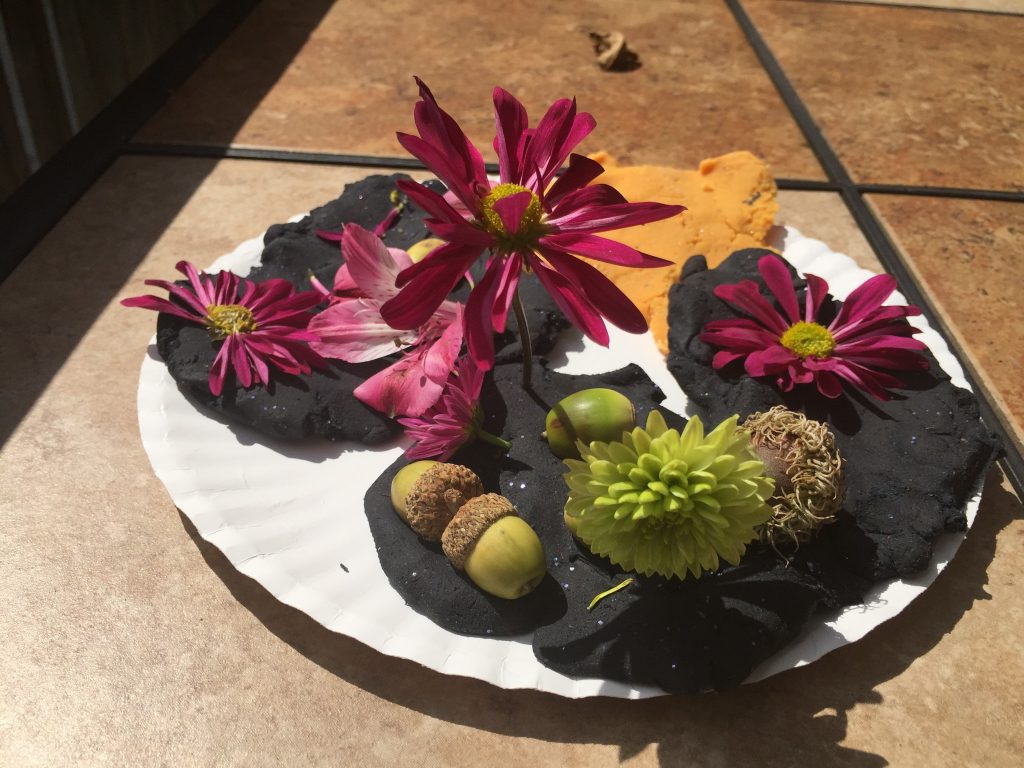
 Thick, thin, make it again
Thick, thin, make it again
Clay snakes are also a great lead-in for this activity, which we then extend into classifying and organizing. The rolling strengthens little wrists and the small muscles of the hand and builds arch development, which will increase children’s endurance for writing and coloring in the future. We often introduce scissors with this activity to cut the snakes into chunks. The clay is firm enough that the child can focus on scissor coordination, rather than struggling with flimsy paper. We also create “fat sticks,” which are actually just clay snakes held vertically, but we try to rotate the clay and twirl it between the thumb and fingers. It works different muscles; call it anything you want!
Mirror, Mirror on the Clay
I recently added unbreakable mirrors to our clay tray, and the children requested them all week long. Mirrors add a new perspective to clay activities. I also think children like to use anything that gives them a base or framework for their projects.


Time, time, time
Clay is calming, always inclusive and always developmentally appropriate. Whether you are dealing with mixed ages, sensory issues or different language-skill levels, clay will meet your students exactly where they are! Each child will interact with the clay at their own level of imagination, confidence and curiosity. Clay responds to rolling, poking, stretching, squeezing or patting. When you are three years old and you don’t get to control much in your life, manipulating that clay can be immensely satisfying! Give them lots of time!
Color
It only bothers you and me. The children honestly don’t care that their yellow, green, blue, pink and purple spiral is slowly turning brown. Ugly brown. I looked at it for months. Only the older, school-aged siblings asked for new clay. Finally, I could stand it no longer. I put it away and started over. Now, when I put out fresh clay, I put out colors that will blend together beautifully. Red, yellow, orange are blending cheerfully. Red, blue and purple is a nice combination. We also used this as a chance to create sets of colors and combinations and patterning of colored balls. Embedding math, that’s our goal.
Wooden Numbers
Dollar Tree stores often sell wooden numbers that you can add to your clay when your students are ready. But don’t rush it. You are building math environments. It will come!

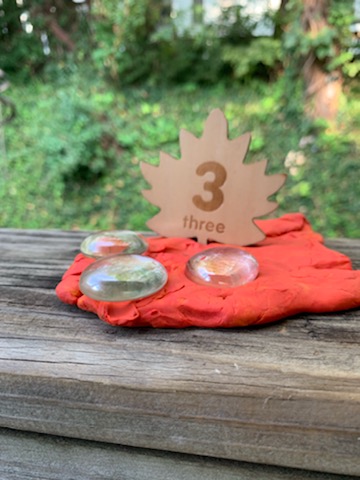
The many benefits of clay
Let your students build their math and science skills through clay. You will see that, by working with clay, children develop eye-hand coordination as they build the small muscles in their fingers and hands. I like to imagine that each child’s brain is taking shape right along with the clay. Neurons and synapses in the brain are generated each time a child explores new ideas through their tactile and visual experiences with this soft, pliable material. Clay also has a uniquely therapeutic quality that settles and calms children. I have seen the busiest children spend an hour or more at our clay table. It’s truly magical—and it’s math. Have fun!




I loved this page. It showed so many creative ways to display shapes and number sense
Learning about shapes and spatail exciting it is about shapes of circles triangles and the different dimensions of geometry and I also learned that u can use clay as well.
I like the way the teacher was teaching the children using Jester’s and letting the kids learn and help at the same time I thought was exciting and learnable for the children.
I like the way the teacher was teaching the children using Jester’s and letting the kids learn and help at the same time.
The videos are helpful when teaching the kids in the classroom about shapes and other geometry that will help them learn as they grow.
I agree with you! There was so much creativity used in all of the activities plus demonstrating how math and shapes are all around us is amazing.
We always use playdough, but I like the idea of using clay as it takes more manipulation and time to create.The use of the trays with a variety of materials to use with the clay is a great idea! Bye, bye cookie cutters!
Hi Laura, I was a play dough groupie, but honestly, I don’t think we will ever go back. I started out small, by removing the cookie cutters, and bringing in loose parts like gems, and bottle caps, straws cut small, etc. Once I discovered clay, it truly changed our play here. It is out daily because it never dries out, and the calmness it adds to the classroom is priceless! Thanks for your comments! Keep us updated on how this is working out for you! Thanks, Diann
I like the lessons using clay.
I love the idea of adding natural elements to clay to allow for further discussion of natural vs artificial shapes.
There were several excellent ideas shared throughout this lesson. The aspect that clay can assist in immersing all children into math, creativity, and problem solving. I liked the reminder of utilizing loose parts with clay instead of the cookie cutters.
I like the idea of getting things out in nature to add to clay creations. The idea of letting children find their own things in nature and go from there will enhance their creativity.
i liked the part when a child joins into to play with clay, the other children give them some of their clay to play with. Teaching them about decomposingand how to problem solve. Teaching children how to share on their own is awesome. This is also teaching adding partsto make a whole.
In our classroom we use scissors to cut the clay which helps the children with finger control and help with cutting skills.
I’m glad found this blog excellent ideas.
Excellent materials to teach shapes.
I enjoyed reading about all the ways you can incorporate math play with clay.
Great ideas! I hope to use these in my classroom as soon as we return to school.
I like how you make the clay more pliable by making snakes first. What a great idea! Also, using real objects when using the clay is a great idea.
I like working with playdough as well, my children will roll a ball and say its a circle, I may flatten it into a flat circle to see if they will still see a circle.
I also tend to go to playdough, for the fact that clay is hard to manipulate for the children, but you’ve opened my eyes to new beginnings. So I will try clay once again. You’ve given us many tips and I love the children’s creations. Very beautiful!
I also tend to go to playdough, for the fact that clay is hard to manipulate for the children, but you’ve opened my eyes to new beginnings. So I will try clay once again. You’ve given us many tips and I love the children’s creations. Very beautiful!
I also tend to go to playdough, for the fact that clay is hard to manipulate for the children, but you’ve opened my eyes to new beginnings. So I will try clay once again. You’ve given us many tips and I love the children’s creations. Very beautiful!
I love the use of natural, loose parts, and other items in the classroom as provocations to explore not only their creativity but their math skills. There were so many math concepts demonstrate with this simple activity that evolved through their problem solving, sorting, and questioning.
I agree that clay does have a therapeutic quality about it that makes it so satisfying. I like the example this person used and how they are exploring shapes and building math skills by having the children contribute each of their own clay and using their imagination and creativity with the loose parts. I still like using the cookie cutters, but this a nice new way to play with the play dough.